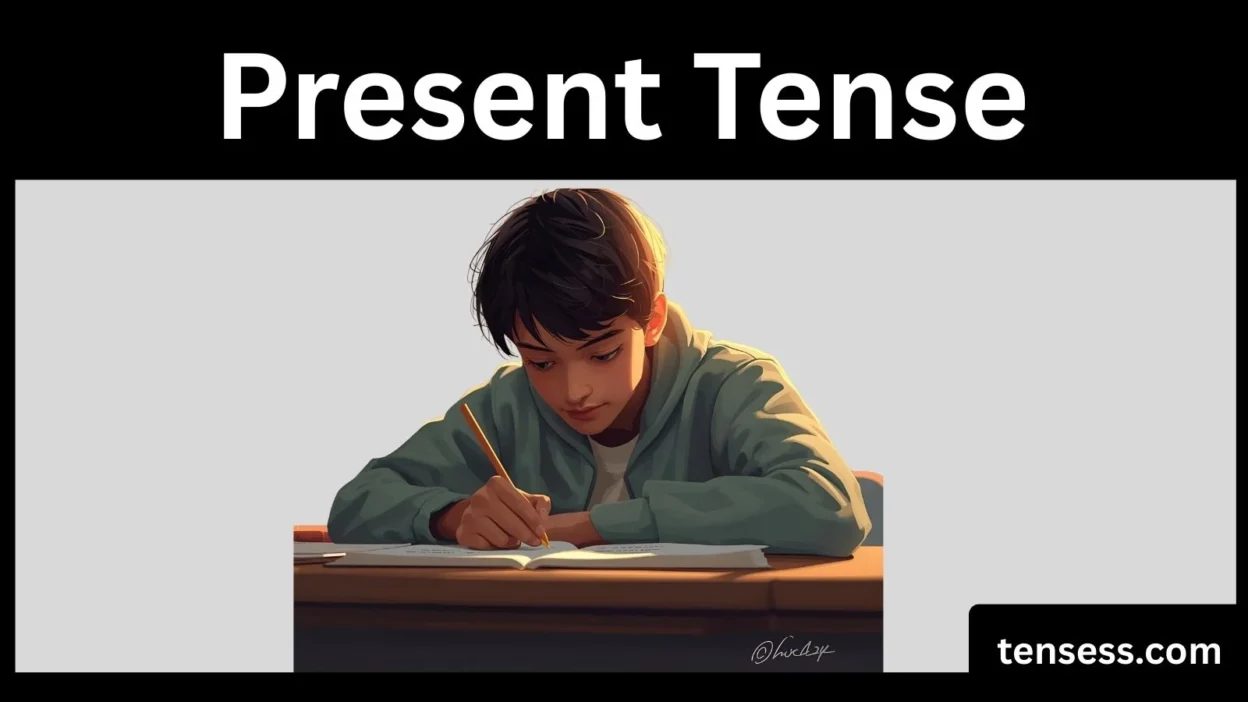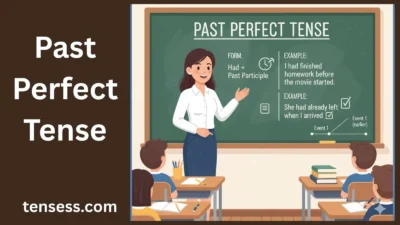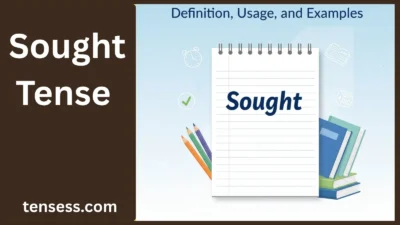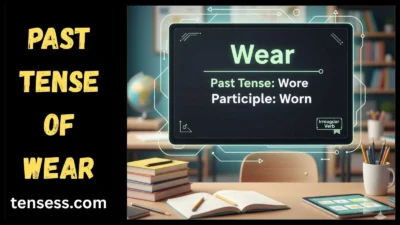The present tense is a cornerstone of English grammar, used to describe actions, habits, facts, and states happening now or regularly.
Whether you’re a student, language learner, writer, or grammar enthusiast, understanding the present tense is essential for clear communication.
This verb tense helps you express what’s happening in the moment, general truths, or routines, like “I walk to school” or “The sun rises in the east.”
In this SEO-optimized guide, we’ll break down the present tense, including its definition, structure, and conjugation, with plenty of verb tense examples to make it beginner-friendly.
You’ll also find practical tips, common mistakes to avoid, and engaging exercises to boost your skills.
Let’s dive into the world of present tense verbs and learn how to use the present tense correctly!
What Is the Present Tense?
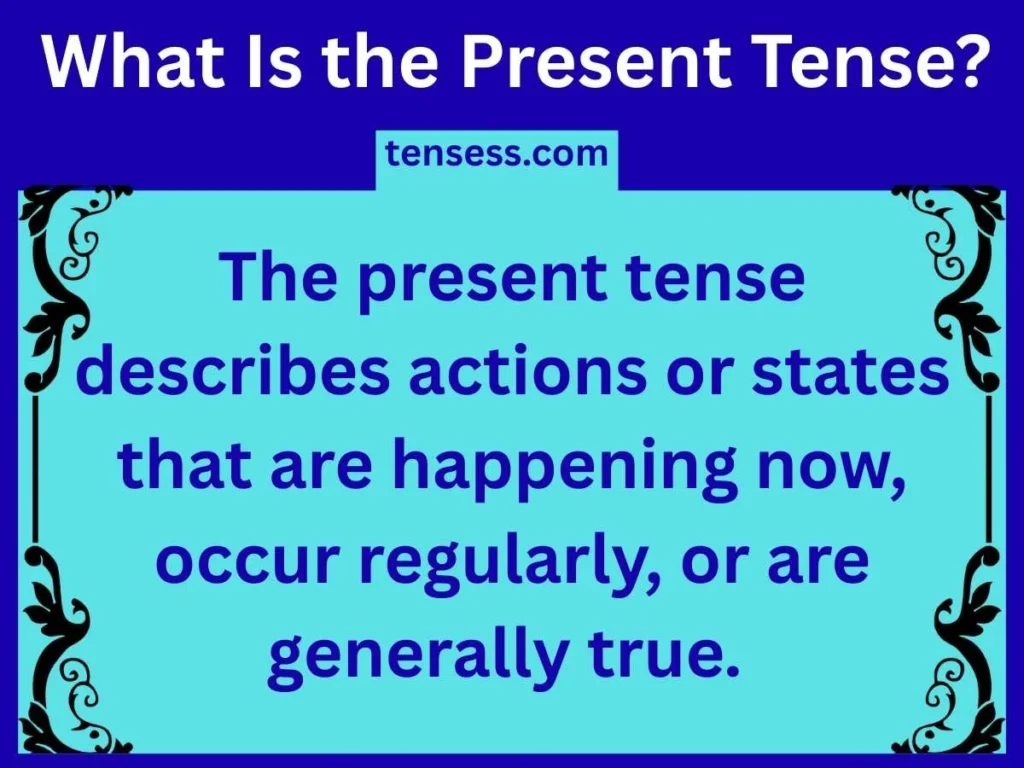
It’s one of the most common verb tenses in English, used for:
- Current actions: “She writes a letter.”
- Habits: “They play soccer every weekend.”
- General facts: “Water boils at 100°C.”
- States or feelings: “I love chocolate.”
There are four types of present tense: simple present, present continuous, present perfect, and present perfect continuous. This article focuses on the simple present tense, the foundation for the others.
How to Recognize the Present Tense?
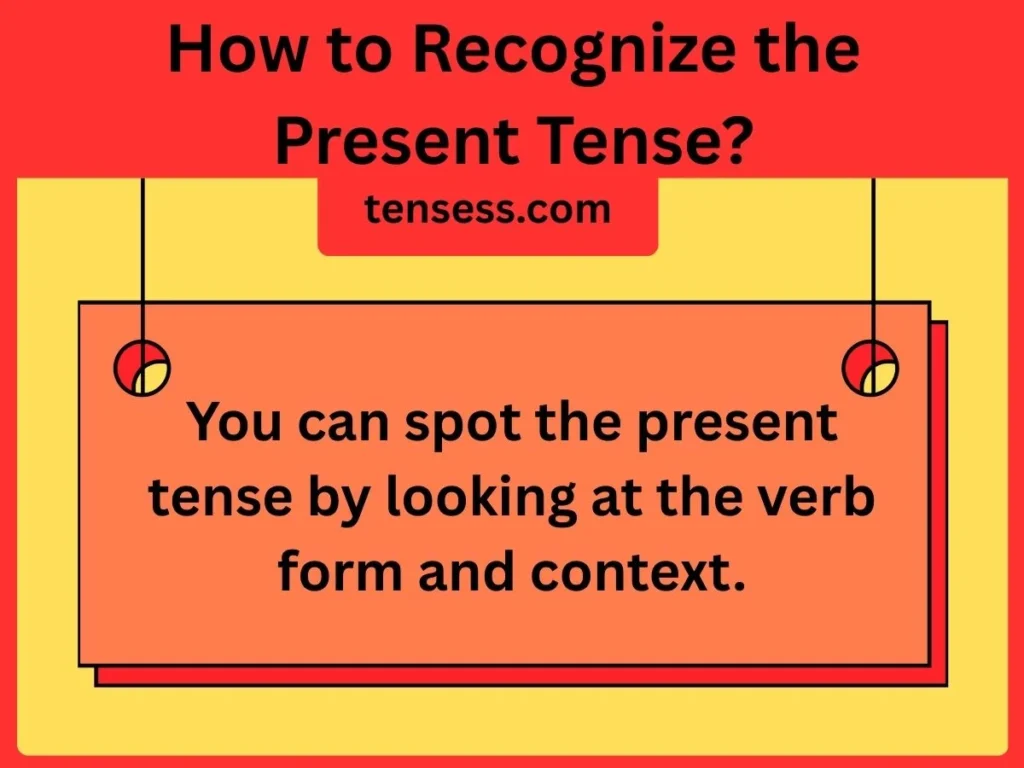
In the simple present tense, verbs typically follow these patterns:
- Base verb for most subjects (I, you, we, they): “I walk.”
- Base verb + -s or -es for third-person singular (he, she, it): “She walks.”
- Time expressions like “always,” “often,” “every day,” or “now” often signal the present tense.
For example, “He studies daily” indicates a routine, while “The dog barks” describes a current action.
Structure of Sentence on Present Tense
The simple present tense follows a clear structure:
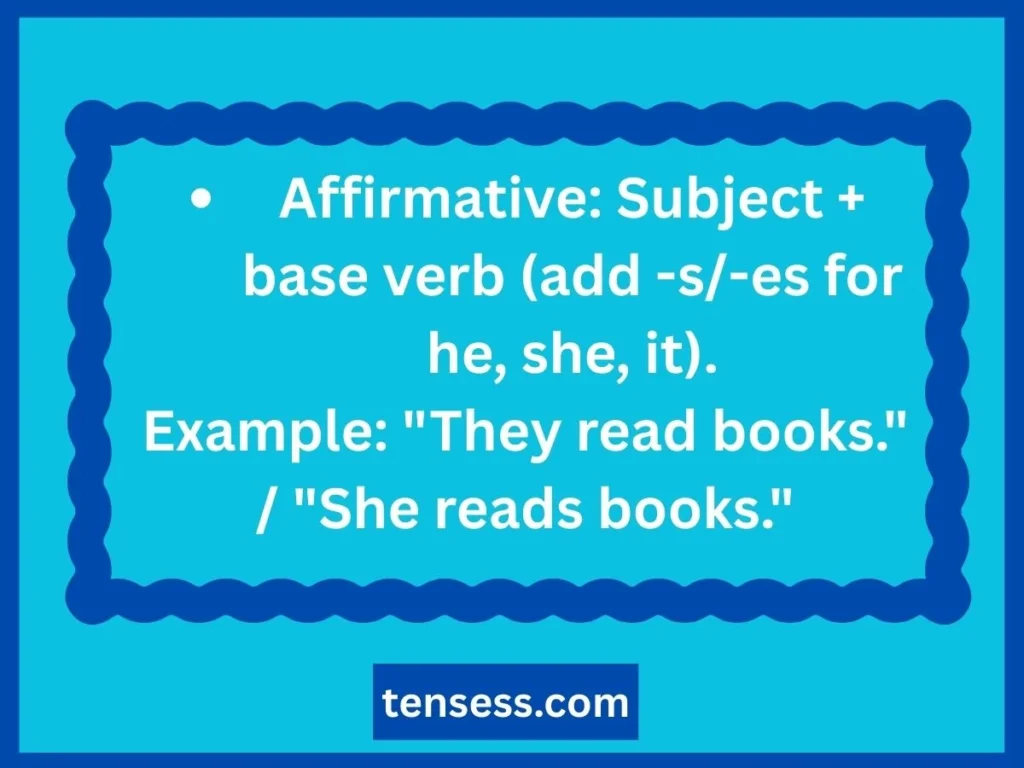
- Negative: Subject + do/does + not + base verb.
Example: “I don’t read books.” / “She doesn’t read books.” - Interrogative: Do/Does + subject + base verb?
Example: “Do you read books?” / “Does she read books?”
This structure makes it easy to form sentences in the present tense.
Formation of Present Tense
To form the simple present tense, follow these rules:
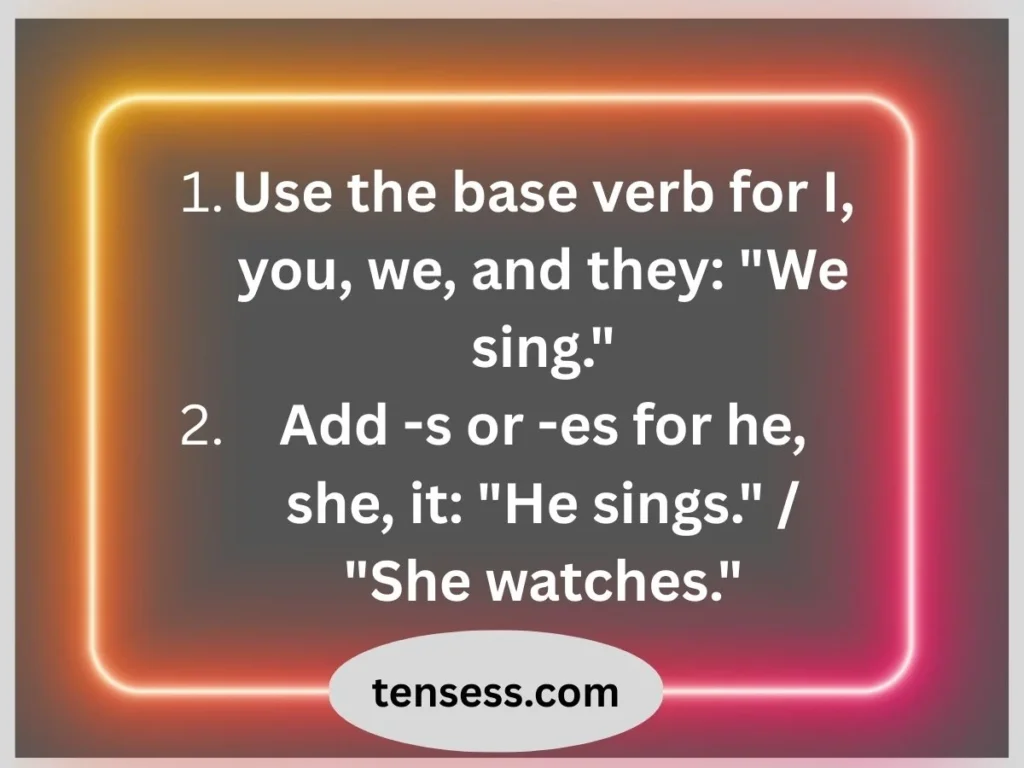
- Use do/does for negatives and questions: “They don’t sing.” / “Does he sing?”
For verbs ending in consonants + -y, change -y to -ies (e.g., study → studies). For verbs ending in -s, -sh, -ch, -x, or -z, add -es (e.g., watch → watches).
Verbs
The simple present tense uses action verbs (e.g., run, write) and stative verbs (e.g., know, like) to describe actions or states. Action verbs show physical or mental actions, while stative verbs express feelings, possession, or states. Examples:
- Action: “I run every morning.”
- Stative: “She knows the answer.”
Helping Verbs
In the simple present tense, helping verbs (do/does) are used for:
- Negatives: “I don’t like coffee.” / “She doesn’t play tennis.”
- Questions: “Do you like coffee?” / “Does she play tennis?”
- Emphasis: “I do want to go!”
The verb “to be” (am, is, are) is also used in present continuous or as a main verb: “She is happy.”
Explanation of Some Verbs with Reference to Present Tense
Here’s how common verbs behave in the simple present tense:
- Go: “I go to school.” / “He goes to school.”
- Have: “We have a dog.” / “She has a dog.”
- Be: “I am tired.” / “They are happy.”
- Do: “You do your homework.” / “He does his homework.”
These verbs follow the standard rules, but some have irregularities (e.g., have becomes has).
Table of Some Regular or Irregular Verbs in Present Tense
| Base Verb | I/You/We/They | He/She/It |
| Walk | walk | walks |
| Run | run | runs |
| Study | study | studies |
| Go | go | goes |
| Have | have | has |
| Do | do | does |
| Be | am/are | is |
| Watch | watch | watches |
| Play | play | plays |
| Write | write | writes |
Simple Sentence Examples
- I walk to the park every day.
- You like to read novels.
- We play soccer on weekends.
- They study English at school.
- She writes a blog daily.
- He runs every morning.
- It rains in the afternoon.
- The dog barks at strangers.
- The children sing in the choir.
- John works at a bank.
Negative Sentence Examples
- I don’t walk to the park on weekdays.
- You don’t like spicy food.
- We don’t play soccer in the rain.
- They don’t study on weekends.
- She doesn’t write emails at night.
- He doesn’t run in the evening.
- It doesn’t rain in summer often.
- The dog doesn’t bark at friends.
- The children don’t sing out of tune.
- John doesn’t work on Sundays.
Interrogative Sentence Examples
- Do I walk too fast?
- Do you like to travel?
- Do we play well together?
- Do they study every night?
- Does she write poetry?
- Does he run in the park?
- Does it rain a lot here?
- Does the dog bark at night?
- Do the children sing in class?
- Does John work late?
Negative and Interrogative Sentence Examples
- Don’t I walk fast enough?
- Don’t you like to dance?
- Don’t we play every weekend?
- Don’t they study hard?
- Doesn’t she write well?
- Doesn’t he run daily?
- Doesn’t it rain often?
- Doesn’t the dog bark loudly?
- Don’t the children sing beautifully?
- Doesn’t John work nearby?
How to Conjugate Present Tense
To conjugate verbs in the simple present tense, follow these steps:
- Use the base verb for I, you, we, they: “I eat.”
- Add -s for he, she, it: “She eats.”
- For verbs ending in -y (after a consonant), change to -ies: “He studies.”
- For verbs ending in -s, -sh, -ch, -x, -z, add -es: “She watches.”
- Use do for questions/negatives with I, you, we, they: “Do you eat?”
- Use does for he, she, it: “Does she eat?”
- Irregular verbs like have: “I have” / “She has.”
- Verb be: “I am,” “You are,” “He is.”
- Add -es to verbs like go: “He goes.”
- Check for exceptions (e.g., do → does).
Conjugation Table (for All Subjects)
| Subject | Eat | Go | Have | Be |
| I | eat | go | have | am |
| You | eat | go | have | are |
| We | eat | go | have | are |
| They | eat | go | have | are |
| He | eats | goes | has | is |
| She | eats | goes | has | is |
| It | eats | goes | has | is |
Spelling Changes or Irregularities
- Consonant + -y: Change -y to -ies (study → studies).
- -s, -sh, -ch, -x, -z: Add -es (watch → watches, buzz → buzzes).
- Irregular verbs:
- Have → has (She has a car).
- Go → goes (He goes home).
- Do → does (She does well).
- Be is unique: I am, you are, he/she/it is, we/they are.
Sentence Examples with Different Subjects
- I love to read books.
- You play guitar beautifully.
- We visit our grandparents weekly.
- They watch movies every Friday.
- He studies math every evening.
- She writes in her journal daily.
- It snows in winter here.
- The cat sleeps on the couch.
- John and Mary work together.
- The children sing in the park.
- I don’t eat meat.
- You don’t like horror films.
- She doesn’t run fast.
- We don’t play chess often.
- They don’t study on weekends.
Common Mistakes with Present Tense
- Forgetting -s/-es for he, she, it: “She walk” → “She walks.”
- Using do instead of does: “Does he plays?” → “Does he play?”
- Overusing -s: “I walks” → “I walk.”
- Confusing be forms: “She are” → “She is.”
- Misplacing not: “I not like” → “I don’t like.”
- Wrong verb form after does: “She doesn’t writes” → “She doesn’t write.”
- Ignoring spelling rules: “He studys” → “He studies.”
- Using -ing incorrectly: “I am walk” → “I walk.”
- Mixing tenses: “She goes and ate” → “She goes and eats.”
- Omitting do/does in questions: “You like?” → “Do you like?”
Explain Frequent Errors and How to Avoid Them
- Forgetting -s/-es: Always check if the subject is he, she, or it.
- Do vs. Does: Use does for he, she, it; do for others.
- Overusing -s: Only add -s for third-person singular subjects.
- Be forms: Memorize am, is, are for correct subjects.
- Not placement: Place not after do/does in negatives.
- Verb form after does: Use the base verb, not -s or -ing.
- Spelling errors: Learn rules for -y and -s/-sh/-ch endings.
- Avoid -ing in simple present: Use present continuous for -ing forms.
- Tense mixing: Stick to present tense for current actions.
- Question structure: Always start with do/does for questions.
Related Verbs and Synonyms for Present Tense
Some verbs are confused with present tense verbs or used interchangeably:
- Like (synonyms: enjoy, love): “I like tea” vs. “I love tea.”
- Want (synonyms: desire, wish): “She wants a car” vs. “She desires a car.”
- Know (synonyms: understand, realize): “They know the truth” vs. “They understand the truth.”
- Go (synonyms: travel, move): “He goes home” vs. “He travels home.”
Sentence comparisons:
- “I like to swim” vs. “I enjoy swimming.”
- “She wants to learn” vs. “She desires to study.”
Tips to Practice Using Present Tense
- Write a daily journal using simple present tense.
- Describe your routine: “I wake up at 7 a.m.”
- Practice with a friend by asking present tense questions.
- Read news articles and identify present tense verbs.
- Use flashcards to memorize irregular verbs like have/has.
- Try online grammar quizzes focused on verb conjugation.
- Speak in present tense during conversations.
- Watch English videos and note present tense usage.
- Create sentence lists with different subjects.
- Use grammar apps to check your present tense sentences.
Frequently Asked Questions
- What is the simple present tense? It describes habits, facts, or current actions.
- When do we add -s or -es? For he, she, it subjects.
- What’s the difference between do and does? Do is for I, you, we, they; does is for he, she, it.
- Can be be a main verb? Yes, e.g., “I am happy.”
- Why is has used instead of have? For he, she, it subjects.
- How do I form questions? Use do/does + subject + base verb.
- What are common present tense mistakes? Forgetting -s or misusing do/does.
- Are there irregular verbs in present tense? Yes, like have/has, go/goes.
- How do I practice present tense? Write, speak, and quiz regularly.
- Can present tense describe the future? Yes, for scheduled events, e.g., “The train leaves at 5 p.m.”
Exercises
- Write 5 simple present tense sentences about your day.
- Convert 5 affirmative sentences to negatives.
- Create 5 present tense questions.
- Correct this sentence: “She don’t likes coffee.”
- Fill in: “He ___ (run) every morning.”
- Change “I study” to interrogative.
- Write a sentence with have for “she.”
- Identify the verb in: “They play soccer.”
- Make a negative sentence with watch.
- Use be in a sentence for “we.”
Quizzes
- What is the correct form? “She ___ (go) to school.”
a) go b) goes c) going
Answer: b) goes - Is this correct? “I walks to work.”
Answer: No, it’s “I walk.” - Choose the right verb: “They ___ happy.”
a) am b) is c) are
Answer: c) are - Negative form of “He plays”?
Answer: He doesn’t play. - Question form of “You read”?
Answer: Do you read? - Correct form for “study” with “he”?
Answer: He studies. - What’s wrong? “She do her homework.”
Answer: It’s “She does her homework.” - Fill in: “We ___ (like) pizza.”
Answer: like - Is “It rain” correct?
Answer: No, it’s “It rains.” - Conjugate “have” for “it.”
Answer: It has.
True or False
- The present tense is only for current actions. False (also habits, facts).
- “She walks” is simple present tense. True.
- “I am walk” is correct. False (it’s “I walk”).
- Does is used for “I.” False (use do).
- “He studies” follows spelling rules. True.
- Be is a regular verb. False (it’s irregular).
- Negatives use don’t/doesn’t. True.
- “They goes” is correct. False (it’s “They go”).
- Questions start with do/does. True.
- “She have a dog” is correct. False (it’s “She has a dog”).
Conclusion
Mastering the present tense is a game-changer for clear and confident communication.
Whether you’re describing daily routines, stating facts, or asking questions, the simple present tense is your go-to tool.
By understanding its structure, conjugation rules, and common pitfalls, you can avoid mistakes and use present tense verbs effectively.
Practice with the exercises and quizzes provided, and try forming your own sentences to build confidence.
For extra help, consider using a grammar checker or joining a language learning community.
Start applying the present tense in your writing and conversations today, and watch your English skills soar! Share your favorite verb tense examples in the comments or try creating a short story using only the simple present tense.
